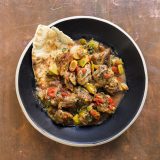In Greece, when there are leftover meat and vegetables to use up, cooks have a solution. It's called tigania, which simply means “from the frying pan,” a catchall term for a braised dish that varies widely by region, even season.
Tigania is traditionally made with small scraps of pork and whatever vegetables are on hand. Both are first seared, then simmered with some kind of liquid to tenderize the tough cuts of meat—normally wine or lemon juice, but also beer and sometimes ouzo. It turns up in bars as meze, casually eaten with toothpicks, but it also makes for a quick meal at home.
“It’s a super-fast thing to do,” says Carolina Doriti, an Athens-based food writer and consultant on Diane Kochilas’ public television show, “My Greek Table.” “Pork is the main version, but it’s very open. Some people like it a bit spicy, so they add paprika. Some like more herbs like oregano or thyme. Some use mustard.”
On the island of Kea, a version that’s stewed with tomatoes and red wine is traditionally served after midnight at weddings or other big events to help keep guests partying through the night. In Crete, it arrives swimming in lemon juice and olive oil. In the Peloponnese, it’s flavored with honey and thyme.
For our own version, we were intrigued by Kochilas' take in “The Glorious Foods of Greece,” which uses white wine and leeks. That's the way tigania is done in the northern region of Macedonia, where leeks have been cultivated since before the time of Socrates. Traditional Macedonian recipes rely heavily on leeks for stews, savory meat pies, even sausage, but they're also stuffed with minced meat and roasted or served braised as the main ingredient of a cold salad.
Kochilas' tigania is fancier than most. She seasons pork shoulder with paprika and sears it before simmering the meat and leeks for more than an hour with mint and orange zest. At Milk Street, we found that country-style ribs were an equally flavorful substitute for pork shoulder. The ribs—which have less connective tissue than shoulder—save time; they cooked nearly halfway through in an initial sear, then became tender after only 30 minutes braising. We also coated the pork in red pepper flakes and oregano to build flavor.
Our recipe calls for braising the pork with six large leeks, a seemingly staggering amount. But they simmered down with white wine, reducing into a creamy, rustic sauce that paired well with the tender meat.
Stirring roasted red peppers and olives into the finished dish brightened it by cutting through the leeks’ creamy richness. For an herbal finish, we sprinkled fresh oregano, a nod that highlighted the dried oregano we'd used in earlier steps.




